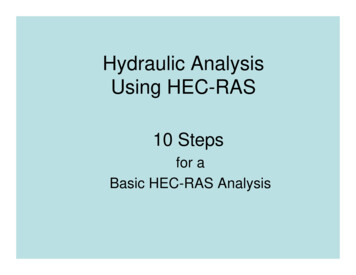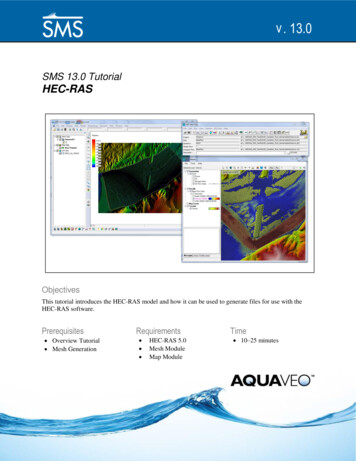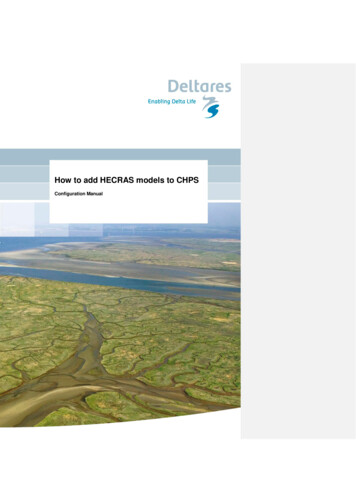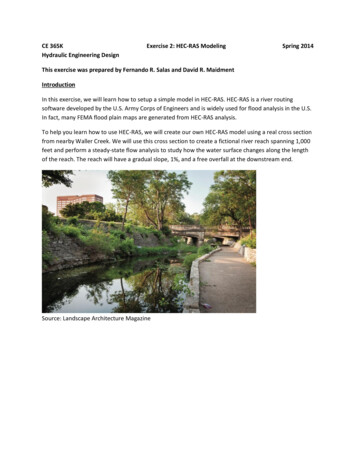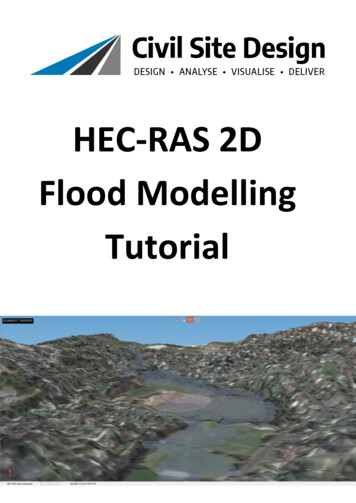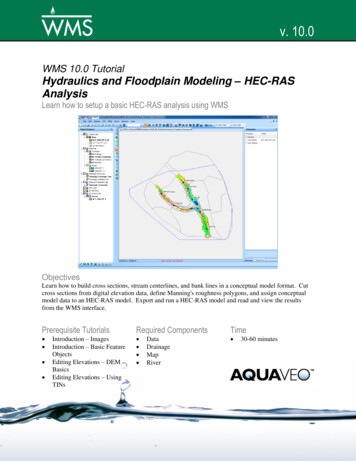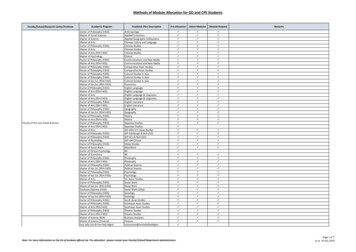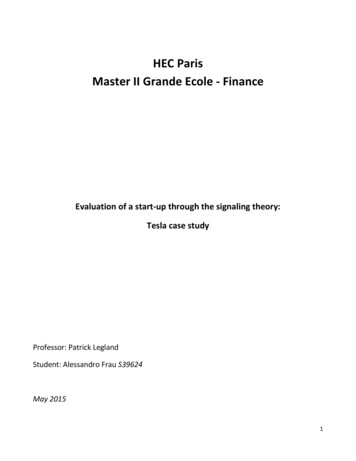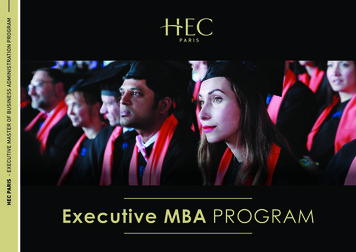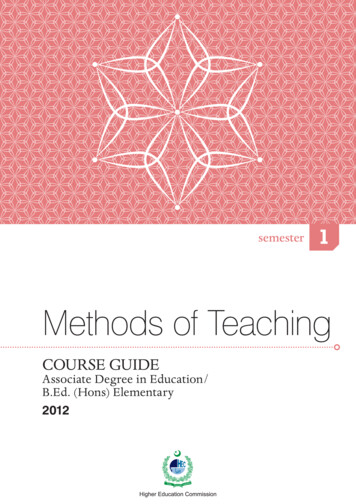
Transcription
semester1Methods of TeachingCOURSE GUIDEAssociate Degree in Education/B.Ed. (Hons) Elementary2012
This product has been made possible by the support of the American People through the United States Agency forInternational Development (USAID). The contents of this report are the sole responsibility of the authors, and donot necessarily reflect the views of USAID or the United States Government.Technical Support: Education Development Centre (EDC); Teachers College, Columbia University
ForewordTeacher education in Pakistan is leaping into the future. This updated Scheme of Studies is the latestmilestone in a journey that began in earnest in 2006 with the development of a National Curriculum,which was later augmented by the 2008 National Professional Standards for Teachers in Pakistan andthe 2010 Curriculum of Education Scheme of Studies. With these foundations in place, the HigherEducation Commission (HEC) and the USAID Teacher Education Project engaged faculty across thenation to develop detailed syllabi and course guides for the four-year B.Ed. (Hons) Elementary andtwo-year Associate Degree in Education (ADE).The syllabi and course guides have been reviewed by the National Curriculum Review Committee(NCRC) and the syllabi are approved as the updated Scheme of Studies for the ADE and B.Ed. (Hons)Elementary programs.As an educator, I am especially inspired by the creativity and engagement of this updated Scheme ofStudies. It offers the potential for a seismic change in how we educate our teachers and ultimately ourcountry’s youngsters. Colleges and universities that use programs like these provide their studentswith the universally valuable tools of critical thinking, hands-on learning, and collaborative study.I am grateful to all who have contributed to this exciting process; in particular the faculty and stafffrom universities, colleges, and provincial institutions who gave freely of their time and expertise forthe purpose of preparing teachers with the knowledge, skills, and dispositions required for nurturingstudents in elementary grades. Their contributions to improving the quality of basic education inPakistan are incalculable. I would also like to thank the distinguished NCRC members, who helpedfurther enrich the curricula by their recommendations. The generous support received from theUnited States Agency for International Development (USAID) enabled HEC to draw on technicalassistance and subject-matter expertise of the scholars at Education Development Center, Inc., andTeachers College-Columbia University. Together, this partnership has produced a vitally importantresource for Pakistan.PROF. DR. SOHAIL NAQVI,Executive Director,Higher Education Commission,IslamabadASSOCIATE DEGREE IN EDUCATION/B.ED. (HONS) ELEMENTARYii
How this course guide was developedAs part of nation-wide reforms to improve the quality of teacher education, theHigher Education Commission (HEC) with technical assistance from the USAIDTeacher Education Project engaged faculty across the nation to develop detailedsyllabi and course guides for the four-year B.Ed. (Hons) Elementary and two-yearAssociate Degree in Education (ADE).The process of designing the syllabi and course guides began with a curriculumdesign workshop (one workshop for each subject) with faculty from universitiesand colleges and officials from provincial teacher education apex institutions.With guidance from national and international subject experts, they reviewed theHEC scheme of studies, organized course content across the semester, developeddetailed unit descriptions and prepared the course syllabi. Although the coursesyllabi are designed primarily for Student Teachers, they are useful resource forteacher educators too.In addition, participants in the workshops developed elements of a course guide.The course guide is designed for faculty teaching the B.Ed. (Hons) Elementaryand the ADE. It provides suggestions for how to teach the content of each courseand identifies potential resource materials. In designing both the syllabi and thecourse guides, faculty and subject experts were guided by the National ProfessionalStandards for Teachers in Pakistan 2009 and the National Curriculum 2006. Thesubject experts for each course completed the initial drafts of syllabi and courseguides. Faculty and Student Teachers started using drafts of syllabi and courseguides and they provided their feedback and suggestions for improvement.Final drafts were reviewed and approved by the National Curriculum ReviewCommittee (NCRC).The following faculty were involved in designing this course guide: Yasmin Junejo,GECE (W) Hyderabad; Sajida Aziz, GCEE (F) Pishin; Aroona Hashim, IERUniversity of the Punjab, Lahore; Rashid Ahmad Noor, RITE (M) Peshawar; FouziaGhias, Fatima Jinnah Women University, Rawalpindi; Habib Elahi Sahibzada, HazaraUniversity, Mansehra; Zakia Ishaq, GCEE (F) Pishin; Muhammad Akhtar, GCET (M)Faisalabad; Hamida Qadir, GECE (W) Hussainabad; Abdul Hafeez, GCET (M)Faisalabad; Syed Munir Ahmad, IER University of the Punjab, Lahore; ZiauddinGCEE Panjgoor; Saira Soomro, University of Sindh; Anila Aziz, GCET (W) DGKhan; Zia-ul-Rehman, GCEE Panjgoor; Muhammad Nabi Khan, GCE (M) Gilgit.iiiHOW THIS COURSE GUIDE WAS DEVELOPED
Subject experts guiding course design: Dr. Margaret Jo Shepherd, Teachers College,Columbia University; Hareem Atif Khan, Consultant.Date of NCRC review: 3 March 2012NCRC Reviewers: Dr. Shagufta, Foundation University College of Liberal Arts andSciences, Rawalpindi; Dr. Javed Iqbal, Karakoram International University, Gilgit;Dr. Ishtiaq, Kohat UniversityASSOCIATE DEGREE IN EDUCATION/B.ED. (HONS) ELEMENTARYiv
Table of ContentsSyllabus08Unit Plans21UNIT 1Teaching and learning school24UNIT 2Classrooms are busy places38UNIT 3Teacher-centred and student-centred methods44UNIT 4Lecture, demonstration, discussion, questions,and cooperative learning50Teacher–student and student–student interactionsthat support learning in the classroom58Designing instruction: goals and objectives,assessment, plans, and materials65Self-regulated learning72UNIT 5UNIT 6UNIT 7Faculty Resources76Handout 1, Unit 1: Summary of conclusions from teacher effectiveness researchHandout 2, Unit 1: Principles and procedures of classroom observationHandout 3, Unit 1: Teacher observation formHandout 4, Unit 1: Direct instructionHandout 5, Unit 1: Social constructivist learning theoryHandout 6, Unit 1: Seven principles of learningHandout 7, Unit 4: Recitation and discussion require different questionsHandout 8, Unit 6: Learning goals vs. activities and assignmentsHandout 9, Unit 6: The concept of formative assessment
SyllabusMETHODS OF TEACHING
METHODS OF TEACHINGYear/semesterYear 1, semester 1Duration (hours)48 hours (16 weeks)Credit value3 creditsPrerequisitesNoneCourse descriptionThis course is an introduction to teaching methods used in primary schools.Because you have been a primary school student, you will recognize some of thesemethods. However, you know them from a student’s perspective rather than from ateacher’s perspective.Teaching methods are often divided into two broad categories: teacher-centred methods (also called direct instruction) and learner-centred methods (also called indirectinstruction or inquiry-based learning). An effective teacher knows several methods,some teacher-directed and others learner-directed. From among these methods, ateacher selects the one method or combination of methods most likely to achieve aparticular lesson’s objectives with a particular group of students.Because teaching and learning interact, a course about teaching must also be aboutlearning. The content and structure of the course is based on two strong claims aboutlearning. First, learning results from what a student already knows, thinks, and does –and only from these actions of the student’s mind. A teacher enables students to learnby influencing what the student does to learn but the student has to do it. Second, asstudents progress through school they should learn to become their own teachers.That is, students should learn how to learn using their teachers as models.Course outcomesBy the completion of this course, Student Teachers will be able to do the following: Describe and discuss their personal theory of teaching and learning based on acritical analysis of implicit theories formed as Student Teachers. Summarize and debate the pros and cons of teacher-centred and learner-centredteaching methods and state their position as a teacher.09COURSE SYLLABUS: Methods of Teaching
Make records of structured, reliable classroom observations and draw conclusionsbased on these observations. Participate in a cooperative learning group that plans, teaches, and critiquesa lesson. Create and critique plans for teaching and learning in primary school classes.Learning and teaching approachesThis is your first opportunity to study teaching and, to a lesser extent, learning inschool. You will soon learn that there are several sources of knowledge about teachingand learning, and you will be introduced to these sources. Because you have yearsof experience as a student but are only beginning to study teaching, this course willprovide you with the opportunity to experience school with a focus on the teacher.You will observe teachers at work in classrooms and interview two students in eachclassroom. You will start your student interviews with two primary school studentsand you will ask about their teachers outside the classroom. You will have a conversation with at least two experienced teachers. You will participate in planning andteaching a lesson to your university classmates, and you will write a plan for a lessonappropriate for primary school students.Experiences of all types have more meaning when you reflect on the experience. Inthis context, reflection means turning your attention inward and searching for connections between the experience you have just had and past experiences. You turn toyour own thoughts, experienced as mental images and words, to discover what youhave learnt through the new experience. Reflection is aided by writing about yourthoughts and by talking about them with other people. This course is organized sothat you complete many of your assignments in collaboration with two or more ofyour classmates and you write three to five times a week in your journal.You are expected to be self-directed in this course. This means that you will arrangeschool visits and find teachers and students to talk with away from school. You alsowill take an active interest in your journal and use it for the purposes for which it isintended. Finally, you will be a responsible member of any group of classmates withwhom you work. The value of this course to your study of teaching will be proportional to the energy and time you invest in the course assignments.ASSOCIATE DEGREE IN EDUCATION/B.ED. (HONS) ELEMENTARY10
Semester outline1Teaching and learning in school (2 weeks, 6hours)UNIT 1:Week #Topics/themesYour experience as a studentStudents currently in schoolPublished research1Sources ofinformation abouteffective teachersObservations in classroomsReflections on classroom observation by yourself andwith othersConversations with experienced teachersTheories about education and instructionThe relationship between teaching and learningYour experience as a studentCurrent students’ self-descriptionsPublished research, especially in cognitive and educational psychology2Sources of information about learningin schoolObservations in classroomsReflections on student interviews by yourself and withothersConversations with experienced teachersTheories about learningCultural influences on teaching and learningYou have been in school for at least 12 years. If you are like other Student Teachers,you probably have a personal theory about teaching and learning that was formedby your experience as a student. You may not be aware of all of these thoughts andbeliefs, but some of them may interfere with learning to teach. In this unit, you willexamine and write in your journal about your existing theory about teaching andlearning so you become fully aware of it. Then you will compare your personaltheory about teaching with other perspectives on effective teaching. You may wantto modify your theories. You will also learn how to observe teachers and students atwork in classrooms.11COURSE SYLLABUS: Methods of Teaching
2UNIT 2:Week #Classrooms are busy places (2 weeks, 6 hours)Topics/themesManaging a crowded spaceWorking with groups and individuals3Sources ofcomplexity in theclassroomManaging different activities occurring at the same timeDiversity among childrenManaging scarce resourcesCoping with unexpected eventsLearn names, interests, and learning strengths fast4ManagingcomplexityEstablish rules and routinesGroup studentsOrganize books and other materials for easy accessCreate pairs of students to help each otherTeaching is a universal human experience: parents teach their children; brothers andsisters teach each other; friends teach friends; employers teach employees; and colleagues teach each other. These examples of teaching usually involve a few studentsat the most and occur in the setting where the learning is used. For example, youngchildren learn about collecting water with their mother at a stream or well, or a childlearns a new game from a group of friends in a playground.Classroom teaching is a special instance of teaching. First, the group is large and diverse,which creates management challenges for the teacher. Second, learning takes place inan unnatural environment, which may create motivation and attention problems for students. People who have not been responsible for teaching in a classroom have difficultyappreciating the complexity of the work. The purpose of this unit is to introduce you, asa prospective teacher, to the complex environment in school classrooms.ASSOCIATE DEGREE IN EDUCATION/B.ED. (HONS) ELEMENTARY12
3Teacher-centred and student-centred methods(2 weeks, 6 hours)UNIT 3:Week #Topics/themesDistinction between lower- and higher-order learningOutcomes from lower-order learningOutcomes from higher-order learningInstructional activities that enable lower-order learning5Key conceptsInstructional activities that enable higher-order learningDirect instruction: a method to enable lowerorder learningIndirect instruction: a method to enable higherorder learningDifferent roles for teachers and studentsTemplate for direct instruction lessonsSample lessonsTemplate for indirect instruction lessons6Model lessonsSample lessonInquiry-based, problem-solving, and project-basedlearning: are these the same or different?Choice: teacher-centred, learner-centred, or both?These two methods are a good place to start your study of teaching methods becausethey are usually seen in opposition to each other, though they can be complementary.Teacher-centred direct instruction is used to help students acquire knowledge andskills. Student-centred indirect instruction is used to help students understand thephysical, social, and psychological world in which they live. In addition to differentgoals, the methods derive from different theories of learning and employ differentpractices. This unit is organized around the view that both methods belong in schools.Knowing and understanding are different but related mental processes; each is a legitimate goal of schooling for all students.13COURSE SYLLABUS: Methods of Teaching
4Lecture, demonstration, discussion, questions,and cooperative learning (3 weeks, 9 hours)UNIT 4:Week #Topics/themesPeer teaching practiceRationale for cooperative learning7Different models of cooperative learningCooperativelearningCooperative learning proceduresIncentive structure of cooperative learningLimitations of cooperative learningChecklists as assessment devicesReasons to lectureStructure of a lectureActive lectures8Lecture,demonstration, anddiscussionStructure of a demonstrationCharacteristics of good discussionPurposes of questionsQuestions in lectures, demonstrations, and discussionsWait time9Asking questionsOpen and closed questionsLessons taught in classAs the previous unit illustrates, the method or practice that a teacher chooses dependson the intended goals for a particular group of students. Teachers have choices not onlyabout teaching methods but also about how they group students for instruction: wholeclass, small groups, pairs, or individuals. A teacher’s decision about grouping is usuallydetermined by a lesson’s goal or objective. For example, if a lesson requires that everystudent in the class have information that is not easily accessible and requires interpretation, the teacher will probably decide to construct a lecture followed by discussion,including questions, for the whole class.This unit has ambitious goals and complicated logistics. Each prospective teacher willbe assigned to one of six cooperative learning groups. Each group’s task is to create six15-minute lessons in total; each method (lecture, demonstration, or discussion) will beemployed in two lessons. All six lessons will include questions. One person from eachgroup will teach the lesson to the rest of the class during the third week of the unit (week9). Three class sessions will be devoted to the lessons (two lessons per day), leaving 15minutes for discussion of the lessons and 15 minutes for continued study of questioningstrategies. The person playing the teacher from each group will be selected at random bydrawing a name from an envelope at the beginning of class on the day of the lesson.ASSOCIATE DEGREE IN EDUCATION/B.ED. (HONS) ELEMENTARY14
5Teacher-student and student-studentinteractions that support learning in theclassroom (2 weeks, 6 hours)UNIT 5:Week ractionsbetween teacherand studentsFairness (justice)TrustInterestEnthusiasmAdaptive teachingCooperative working relationships are central11Constructiveinteractionsbetween studentsExamples of cooperative working relationshipsFeelings are the foundation of thoughtImportance of trust and confidenceWhile studying unit 2 in this course, you had the chance to watch a teacher andstudents at work in two different classrooms and discuss the observations with yourcolleagues. Hopefully, you could see that classrooms are unusual social environments.One adult is expected to allocate limited resources (space, time, learning tools, andattention) equitably among approximately 40 students.Students are expected to sit for long periods and pay continuous attention to theirlessons. Each student’s competence is on public display all the time. The teacher issupposed to have eyes that rotate 360 degrees to know what each student in the classis doing most of the time. In this unit you will learn that a teacher and students canturn an unusual social environment into an environment that supports learning.You and your partners will observe in two more classrooms during the next twoweeks. In each classroom you will observe a teacher interacting with two students andthose students interacting with each other. In each classroom the teacher will choosethe students whom you will observe.15COURSE SYLLABUS: Methods of Teaching
6Designing instruction: goals and objectives,assessment, plans, and materials (4 weeks, 12hours)UNIT 6:Week #Topics/themesLearning principles12Sources ofknowledge fordesigning lessonsPakistan’s primary school curriculumDefinitions of standards, goals, and objectivesExamples of standards, goals, and objectivesBloom’s Taxonomy of Educational Goals and ObjectivesDefinition of assessment in schoolsPersonal experience with assessmentAssessment practices in schools in Pakistan13AssessmentPurposes of assessmentDistinction between formative and summativeassessmentExamples of formative assessmentSources of instructional materials, including textbooks,in Pakistan14InstructionalmaterialsSchool budgets for instructional materialsLow- and no-cost materials to supplement or substitutefor materials provided by the governmentExamples of materials created from local resources byteachers for mathematics, science, and literacyReview of teaching methods and instructional andlearning principles15Review andsynthesisReview of students’ current personal theories ofteaching and learningSearch for synthesisComplete instructional design project (lesson plan)Presentation of lesson plans designed by studentsTeachers started using learning objectives (also called learning outcomes) to designlessons about 50 years ago. Previously, lessons were named by the topic rather thana learning outcome. For example, a topic would be more general, such as ‘Addingtwo-digit numbers’, rather than something specific, such as ‘All students will correctlysolve at least 8 out of 10 problems involving the addition of two-digit numbers’.Teachers have more than one way to write learning objectives.You have seen different formats for lesson plans, and some plans have more partsthan others. Though there are differences in the number of parts a plan may have,all lesson plans have objectives, or a sequence of activities (and necessary materials)for achieving the objectives, and a means for collecting evidence that students haveachieved these outcomes. In this unit, you will learn how to write learning outcomesASSOCIATE DEGREE IN EDUCATION/B.ED. (HONS) ELEMENTARY16
and to choose or create assessments. You will use knowledge you have acquiredabout methods to create and write a teaching plan. You will learn to find or create thematerials that you need to use your plan. You will do some work on the lesson plan inclass with the two people with whom you have visited schools. During the last weekof the unit (week 15) you will review what you have learnt about teaching methodsand learning and instructional principles and then compare that knowledge with yourcurrent personal theories of teaching and learning.7UNIT 7:Week #Self-regulated learning (1 week, 3 hours)Topics/themesBecoming your own teacher16Self-regulatedlearningParents and teachers attitudes towards self-regulatedlearningInterdependence between learning and motivationIntrinsic and extrinsic motivationMastery learning goals and performance learning goalsYou know that learning is not confined to school. Children learn to walk and talk beforethey go to school. People continue to learn after they go to work. Ultimately, peoplelearn throughout their lives. When you think about your own experience in school, youwill probably also conclude that as you progressed through school, the work got harderand you had more responsibility for learning. (Learning in school can also be calledstudying.) The fact that learning is continuous in people’s lives is partly responsible forthe belief that children should ‘learn how to learn’ while they are in school.The purpose of this unit is to introduce you to the process of learning how to learn.You will probably become aware of mental actions that you take without thinkingabout them (e.g. ensuring that you understand what you are reading in preparationfor a test.) As you study the unit, try to think of yourself both as a student (which youare) and as a teacher (which you are becoming) because you are learning about mentalactions that you will teach your students.ReferencesM. Boekarts, Motivation to Learn (Educational Practice Series No. 10) (Geneva:International Bureau of Education, 2002.ØØ ials/publications/educational-practices.htmlJ. Brophy, Teaching. (Educational Practice Series No. 1) (Geneva: International Bureau ofEducation, 1999).ØØ SE SYLLABUS: Methods of Teaching
M. A. Dasgupta, Low-Cost, No-Cost Teaching Aids (New Delhi: National Book Trust,New Delhi).ØØ nocost.pdf M. J. Elias, Academic and Social-Emotional Learning. (Educational Practice Series No. 11)(Geneva: International Bureau of Education, 2003).ØØ tices.htmlW. Harlan and J. Elstgeest, UNESCO Sourcebook for Science in the Primary School (Paris:UNESCO, 1973).ØØ rimary.pdf B. Rosenshine, Principles of Instruction (Educational Practice Series No. 21) (Geneva:International Bureau of Education, 2010). Available at:ØØ , ‘What Makes a Good Teacher? Opinions from Around the World’ (1996) http://www.unicef.org/teachers/teacher/teacher.htm , accessed on 23 February 2013.S. Vosniadou, How Children Learn. (Educational Practice Series No. 7) (Geneva:International Bureau of Education, 2001).ØØ ials/publications/educational-practices.htmlWest Virginia Department of Education, ‘Examples of Formative Assessment’, eAssessment.html ,accessed 5 March 2013.Grading policyA variety of assessments should be used to assess Student Teachers learning. Itis recommended that course work count towards at least 50% of the final grade.Instructors will advise at the start of the course about which pieces of course work(assignments) will be graded. The remainder of the grade will be determined byexams at the middle and end of semester.ASSOCIATE DEGREE IN EDUCATION/B.ED. (HONS) ELEMENTARY18
Course assignmentsReflective journalEach Student Teacher will need a spiral-bound notebook to use as a reflective journal.This journal will be used for specific assignments (e.g. development and continuousrevision of a personal theory of teaching and of learning) and for classroom observations. In sum, the journal will function simultaneously as a repository for certainassignments and as a diary for recording experiences connected with the course (e.g.classroom observations). Advise Student Teachers either to leave a wide margin whenthey write or to leave one side of each page blank so that you can record your reactions to their work and they can go back and record their own reactions to text theyhave written earlier (e.g. personal theory of teaching and of learning).Classroom observationsThe course includes nine classroom observations. The course syllabus indicates thatStudent Teachers may have to locate the schools in which they will observe. If theteachers approve, form triads among the class so that three people will observe inthe same class at the same time. Each triad should remain together throughout thesemester. Observing in triads has two purposes.First, it allows for a richer conversation about the observation, and second, itallows the Student Teachers to talk about and reflect on teaching and learning withcolleagues. Hopefully, this habit will extend to their teaching careers. Explain thatobserving and recording what they see is necessary but not sufficient. The value ofthe observations comes from talking and thinking about them.The nine observations are planned for units 1, 2, and 5. Each set of observations has adifferent purpose. The first two observations are of teachers’ actions during a lessonusing a checklist created from research on teacher effectiveness. Two teachers are tobe observed in different class levels (in classes 1–8) and different subject matters (e.g.maths, Urdu, science). The third observation is of a teacher’s movement in the classroom during a lesson. The fourth and fifth observations are in the same classroomand are of a teacher interacting with two children, one who is academically in the topquarter of the class and one from the bottom quarter. The remaining four observations occur in two classes, again with children of varying ages and with differentsubject matters. Classes will be selected based on teachers’ selections of two children,one of whom is considered more popular and one who is considered less popular.Here the interaction of the two target children with other children in the class willbe observed. Each type of observation (teacher alone; teacher–child interactions,and child–child interactions) requires data collection forms, the forms for which areincluded among the handouts.Interviews with childrenThe course requires 10 interviews with children. The first interviews are with twoprimary school children who are to be asked their views about good teachers. Theneach triad will interview four children (two high achievers and two low achievers)during lessons in classes where the first observation was conducted. Student Teacherswill create their own interview questions. The purpose of the interviews is to learn19COURSE SYLLABUS: Methods of Teaching
children’s opinions about school, the teacher, and of themselves as students. The other four interviews are with two popular children and two less popular children, one ofeach from a different class. The interviewers will determine the questions, which canbe the same as those used for the first set of interviews. For each set of interviews, theinterviewers might consider asking each child, ‘If you could change one thing aboutschool and one thing about the teacher in the class we just visited, what would it be?’Summaries of these interviews, including the questions asked and interpretations,become journal entries.Teaching a lessonThis assignment is described in the course syllabus. It is a group project, and itspurpose is twofold: to plan and critique a lesson using a lecture, discussion, or demonstration and to work in a group using cooperative learning.Divide the class into six groups. Prepare six slips of paper, two with ‘lecture’ writtenon them, two with ‘discussion’, and two with ‘demonstration’. Put them in a bag orenvelope. Have one member from each group draw a slip from the envelope. Thelab
Table of Contents. Syllabus. 08. Unit Plans 21. UNIT. 1 Teaching and learning school 24 UNIT. 2 Classrooms are busy places 38 UNIT. 3 Teacher-centred and student-centred methods 44 UNIT. 4 Lecture, demonstration, discussion, questions, and cooperative learning 50 UNIT. 5 Teacher-student and student-student interactions that support learning in the classroom 58 UNIT. 6 Designing instruction .
